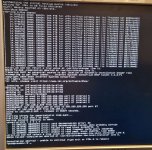I am in the process of installing proxmox ve 9 on my dell r510 it has run with proxmox before so it shouldn't be a problem.
I had to change the RAID controller as we would rather manage all disks directly in Proxmox, so they are set to run in RAID0 on each disk so there are 7 disks, I have tried with Rufus and balenaEtcher but I get a strange error.
I have tested all the hardware in iDRAC and there are no errors on any of it, not even RAM.
So now I am stuck and have no idea what the next move should be, so I hope someone here with the wise stones.
I have also used intel_iommu=off and have tried a lot of different settings in the BIOS, I start the machine without UFEI but with BIOS instead.
I am desperate now hoping for your help
I had to change the RAID controller as we would rather manage all disks directly in Proxmox, so they are set to run in RAID0 on each disk so there are 7 disks, I have tried with Rufus and balenaEtcher but I get a strange error.
I have tested all the hardware in iDRAC and there are no errors on any of it, not even RAM.
So now I am stuck and have no idea what the next move should be, so I hope someone here with the wise stones.
I have also used intel_iommu=off and have tried a lot of different settings in the BIOS, I start the machine without UFEI but with BIOS instead.
I am desperate now hoping for your help


